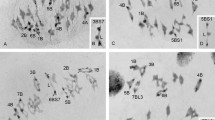Summary
Autotetraploid gene segregation was studied in Zea mays L. using a marking system of two very closely linked genes (A 1 and Sh 2) in the repulsion phase. This system makes it possible to identify many euploid and aneuploid genotypes and enables the estimation of some parameters of autotetraploid gene segregation such as double reduction, numerical nondisjunction, and the relative transmission frequencies of monosomic, disomic, and trisomic gametes. It was found that these three types of gametes did not function at the same rates on the male and female sides. Differences in observed segregation ratios between reciprocal testcrosses were explained by this phenomenon. Estimates of the frequency of double reduction were made for loci used after eliminating the effect of numerical non-disjuction on the segregation ratios. The value of double reduction appears to be the same in the male and female tetrasomic tetraploid. Tetraploids which were disomic for chromosome 3 were not isolated although they might be expected to be common in the progeny of self-fertilized or sib-crossed trisomic tetraploids. Their absence may be explained in part by the low rate of transmission of monosomic gametes from the male parent. Autotetraploid populations which are unstable for chromosome number probably achieve an equilibrium between forces which produce aneuploidy and forces which remove aneuploids from the population.
Similar content being viewed by others
Literature
Blakeslee, A. F., Belling, J., Farnham, M. E.: Inheritance in tetraploid Daturas. Bot. Gaz. 76, 319–373 (1923).
Burnham, C. R.: Discussions in Cytogenetics. Minneapolis: Burgess Publishing Co. 1962.
Catcheside, D. G.: Double reduction and numerical non-disjunction in maize. Heredity 10, 205–218 (1956).
Catcheside, D. G.: Segregation in tetraploid potatoes. Heredity 13, 403–407 (1959).
Doyle, G. G.: Preferential pairing in trisomics sof Zea mays. In: Chromosomes Today vol. 2, 12–20. Edinburgh: Oliver and Boyd 1969.
El-Ghawas, M. I.: A cytogenetic study of segregation in autotetraploid maize involving genes at different distances from the centromere. Ph. D. thesis Cornell University, Ithaca, N.Y. (1955).
Fisher, R. A., Mather, K.: The inheritance of style length in Tythrum salicaria. Ann. Eugenics 12, 1–23 (1943).
Gilles, A., Randolph, L. G.: Reduction of quadrivalent frequency in autotretraploid maize during a period of ten years. Amer. Jour. of Bot. 38, 12–17 (1951).
Haldane, J. B. S.: The theoretical genetics of autopolyploids. Jour Genetics 22, 259–272 (1930).
Kadam, B. S.: Chromosome studies in relation to fertility and vigor in inbred and open pollinated strains of autotetraploid maize. I. Behavior of 40-chromosome plants. Indian Jour. Genetics and Plant Breeding 4, 8–22 (1944).
Mather, K.: Reductional and equational separation of the chromosomes in bivalents and tetravalents. Jour. Genetics 30, 53–78 (1935).
Mather, K.: Segregation and linkage in autotetraploids. Jour. Genetics 32, 287–314 (1936).
Morrison, J. W.: Chromosome behavior and fertility of Tetra Petkus rye. Canadian Jour. of Agr. Sci. 36, 157 to 165 (1956).
Morrison, J. W., Rajhathy, T.: Frequency of quadrivalents in autotetraploid plants. Nature 187, 528–530 (1960).
Muller, H. J.: A new mode of segregation in Gregory's tetraploid primulas. Amer. Nat. 48, 508–512 (1914).
Randolph, L. F.: Cytogenetics of tetraploid maize. Jour. Agr. Research 50, 591–605 (1935).
Shaver, D. L.: A comparison of meiosis in perennial teosinte (4n), tetraploid maize and their hybrid. Caryologia 15, 53–57 (1962a).
Shaver, D. L.: A study of aneuploidy in autotetraploid maize. Canadian Jour. Genetics 4, 226–234 (1962b).
Weber, D. F.: The use of monosomy to detect genes altering recombination in Zea mays. Maize Genetic Cooperative News Letter 45, 32–35 (1971).
Author information
Authors and Affiliations
Additional information
This paper is dedicated to Dr. M. M. Rhoades.
Cooperative investigations of the Plant Science Research Division, Agricultural Research Service, U.S. Department of Agriculture, and the Agronomy Department, Missouri Agricultural Experiment Station. Journal Series No. 6557.
Rights and permissions
About this article
Cite this article
Doyle, G.G. Autotetraploid gene segregation. Theoret. Appl. Genetics 43, 139–146 (1973). https://doi.org/10.1007/BF00306563
Received:
Issue Date:
DOI: https://doi.org/10.1007/BF00306563




